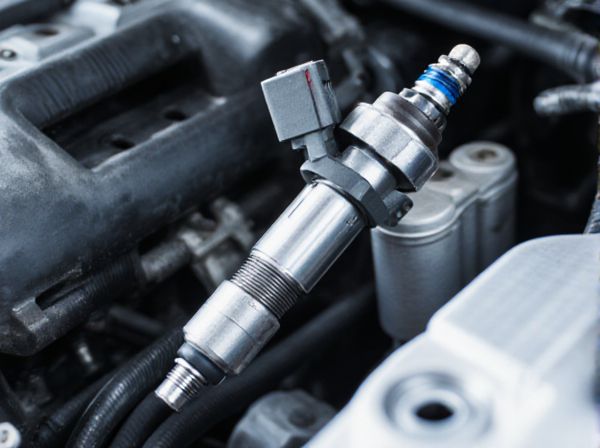
Photo illustration: Solenoid-actuated vs Piezoelectric
Solenoid-actuated devices generate motion through electromagnetic forces, providing strong and reliable linear or rotary movements ideal for applications requiring high force and rapid actuation. Piezoelectric actuators convert electrical energy directly into precise mechanical displacement, offering exceptional accuracy and fast response with minimal energy consumption, suitable for micro-positioning tasks. Understanding the key differences helps you select the optimal actuator for your specific performance and efficiency needs.
Table of Comparison
| Feature | Solenoid-Actuated Injector | Piezoelectric Injector |
|---|---|---|
| Operating Principle | Electromagnetic solenoid controls injector valve | Piezoelectric crystals change shape to control injector valve |
| Response Time | Moderate (milliseconds) | Fast (microseconds) |
| Fuel Delivery Precision | Less precise, limited injection control | Highly precise, multiple injection phases possible |
| Durability | Robust, common in mass production | More sensitive, requires advanced materials |
| Cost | Lower initial cost | Higher initial cost |
| Application | Widely used in conventional gasoline and diesel engines | Used in modern engines to optimize emissions and fuel efficiency |
Introduction to Solenoid-actuated and Piezoelectric Technologies
Solenoid-actuated technology uses electromagnetic coils to create linear motion by converting electrical energy into mechanical movement, commonly applied in valve control and automotive systems. Piezoelectric technology generates precise mechanical displacement through voltage-induced deformation of piezoelectric materials, often utilized in high-resolution sensors and actuators. Both technologies offer distinct advantages in speed, force, and precision, shaping their respective roles in industrial automation and microelectromechanical systems (MEMS).
Principle of Operation: Solenoid-actuated vs Piezoelectric Devices
Solenoid-actuated devices operate using an electromagnetic coil that generates a magnetic field to move a ferromagnetic plunger, converting electrical energy into linear mechanical motion. Piezoelectric devices utilize materials that deform when subjected to an electric field, creating precise mechanical displacement through the piezoelectric effect. The solenoid mechanism is favored for larger force requirements and longer strokes, while piezoelectric actuators excel in high precision, rapid response, and minimal energy consumption.
Key Components and Design Differences
Solenoid-actuated valves rely on an electromagnetic coil and plunger mechanism to control fluid flow, enabling straightforward design with robust mechanical movement suitable for high-force applications. Piezoelectric actuators use crystalline materials that deform under electrical voltage, offering precise control, rapid response times, and minimal power consumption in compact, lightweight designs. Key design differences include the solenoid's reliance on magnetic fields and mechanical displacement versus the piezoelectric's direct material strain effect, impacting durability, energy efficiency, and operational frequency ranges.
Energy Efficiency and Power Consumption
Solenoid-actuated systems typically consume higher power due to continuous current requirements for coil activation, resulting in lower energy efficiency compared to piezoelectric actuators. Piezoelectric actuators convert electrical energy directly into mechanical displacement with minimal power loss, making them highly energy-efficient for precision applications. The reduced power consumption and faster response times of piezoelectric devices contribute to extended operational life and lower energy costs.
Response Time and Operational Speed
Solenoid-actuated valves typically exhibit slower response times, ranging from 5 to 20 milliseconds, due to mechanical inertia and coil energizing delays. Piezoelectric actuators offer superior operational speed, with response times as fast as 1 millisecond or less, enabled by direct deformation of the piezo material without moving parts. Faster response and higher switching frequencies in piezoelectric actuators make them ideal for precision fluid control applications requiring rapid actuation.
Durability and Maintenance Requirements
Solenoid-actuated devices offer robust durability with a lifespan typically extending beyond 10 million cycles, requiring periodic inspection and coil replacement due to mechanical wear and heat buildup. Piezoelectric actuators exhibit exceptional longevity with minimal wear since they operate without moving parts, significantly reducing maintenance needs and enhancing reliability in high-precision applications. Maintenance routines for solenoids involve mechanical checks and electrical testing, while piezoelectric systems primarily require monitoring of electrical insulation and occasional calibration to maintain optimal performance.
Performance in Precision Applications
Solenoid-actuated actuators provide strong, rapid linear motion well-suited for moderate precision tasks but can suffer from hysteresis and limited repeatability in high-precision applications. Piezoelectric actuators excel in ultra-precise positioning with nanometer-scale resolution and fast response times, making them ideal for applications in microscopy, semiconductor manufacturing, and precision optics. The inherent stiffness and minimal mechanical wear of piezoelectric devices enhance long-term stability, outperforming solenoid actuators in sustained precision environments.
Cost Analysis and Economic Considerations
Solenoid-actuated actuators generally offer lower initial costs due to simpler manufacturing processes and widespread availability, making them a cost-effective choice for applications requiring moderate precision. Piezoelectric actuators, while more expensive upfront because of advanced materials and complex fabrication, deliver higher precision and faster response times, potentially reducing long-term operational costs in high-accuracy industries such as semiconductor manufacturing. Economic considerations must weigh the total cost of ownership, factoring in maintenance, energy consumption, and performance requirements to determine the most cost-efficient actuator type for specific applications.
Common Applications and Industry Use Cases
Solenoid-actuated systems are widely used in automotive applications for valve control, industrial automation for pneumatic and hydraulic actuation, and door locking mechanisms due to their durability and cost-effectiveness. Piezoelectric actuators find common applications in precision instrumentation, medical devices like ultrasound imaging, and semiconductor manufacturing where high-speed, high-precision movement is critical. Both technologies cater to different industry needs: solenoids excel in robust, high-force scenarios, while piezoelectrics dominate in fields requiring micro- or nano-scale accuracy and rapid response.
Future Trends and Technological Advancements
Solenoid-actuated valves are evolving with enhancements in electromagnet efficiency and miniaturization, enabling faster response times and improved durability for industrial automation applications. Piezoelectric actuators are advancing through the integration of nanomaterials and novel ceramics, significantly increasing their precision and energy efficiency in medical devices and microfluidics. Future trends indicate a convergence of these technologies, leveraging intelligent control systems and AI-driven diagnostics to optimize performance and extend lifespan across diverse sectors.
 caratoz.com
caratoz.com